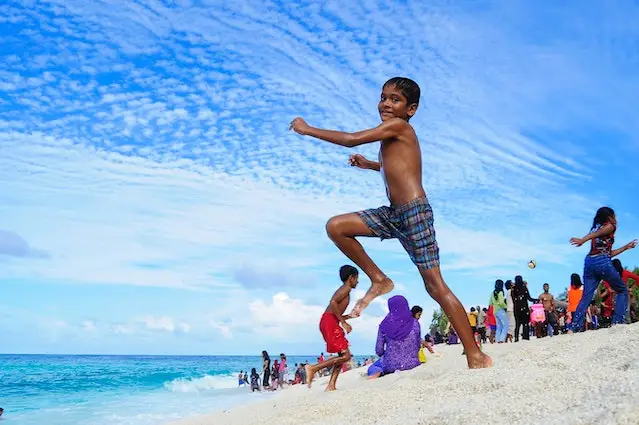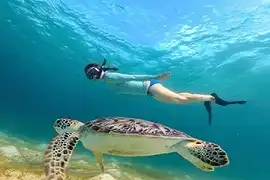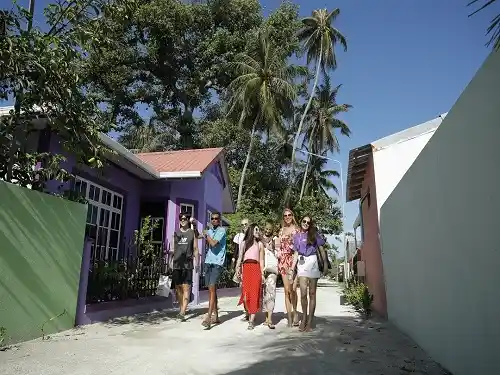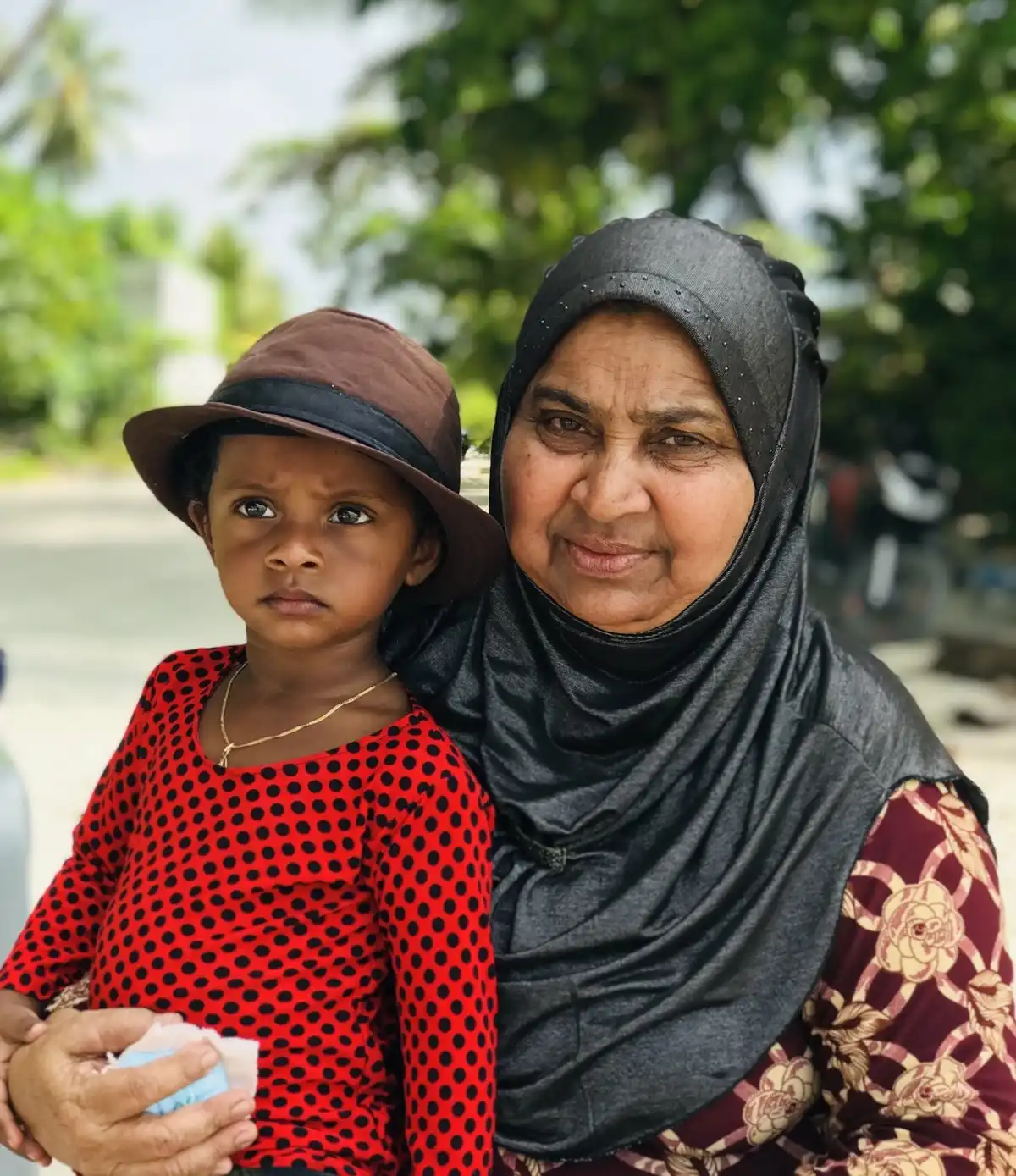Discover a lush northern paradise with unique mangrove ecosystems, verdant vegetation, pristine beaches, and authentic Maldivian lifestyle in the remote Haa Alifu Atoll
Located in the Haa Alifu Atoll in the northern Maldives, Maarandhoo Island offers visitors a rare glimpse into authentic Maldivian island life in one of the country's most pristine and remote regions. This peaceful island maintains its natural beauty and cultural heritage while providing access to some of the Maldives' most untouched environments.
What makes Maarandhoo special is its unusually lush vegetation and unique mangrove ecosystems. Unlike many Maldivian islands that feature primarily palm trees and beach vegetation, Maarandhoo boasts a more diverse plant life, including mangrove areas that provide critical habitat for various species. The island's relatively large size and natural freshwater sources have supported this rich biodiversity, creating a greener landscape than many other Maldivian islands.
Visitors to Maarandhoo are drawn by its verdant environment, pristine beaches, exceptional snorkeling opportunities, and chances to engage with local community life. The island's remote location in the northern Maldives means fewer tourists and a more authentic experience, while its natural environment offers diverse activities both on land and in the surrounding crystal-clear waters.
Maarandhoo Island is situated in the northern part of the Maldives in Haa Alifu Atoll, approximately 330 kilometers north of Male. This remote location in the northern atolls provides a more pristine and less-visited environment compared to islands closer to the capital.
Its position within Haa Alifu Atoll offers access to some of the Maldives' most spectacular diving and snorkeling sites, with healthy coral reefs and abundant marine life. The northern atolls are known for their exceptional biodiversity both above and below the water.
Maarandhoo Island stands out among Maldivian islands for its unusually verdant landscape and unique mangrove ecosystems, offering visitors a glimpse into a different aspect of Maldivian natural environments that differs from the typical palm-fringed beaches.

Maarandhoo features unusually diverse plant life for a Maldivian island, with a variety of native trees, shrubs, and flowering plants creating a greener landscape than many other islands in the archipelago.

The island is known for its small but ecologically important mangrove areas that provide critical habitat for juvenile fish, crustaceans, and birds, creating a unique ecosystem rarely found on inhabited Maldivian islands.

Beyond its verdant interior, Maarandhoo boasts untouched white sand beaches with crystal-clear waters, offering the classic Maldivian beach experience without the crowds found on more developed islands.

Maarandhoo is home to a close-knit community that has maintained traditional island values and sustainable practices, offering visitors authentic cultural interactions rarely found in more touristic areas.
Maarandhoo's natural environment includes several distinctive elements:
These ecological features make Maarandhoo an ideal destination for travelers interested in experiencing a different aspect of Maldivian natural environments and understanding the diverse ecosystems that exist throughout the archipelago.
The Maarandhoo community maintains several sustainable practices:
These practices have helped maintain the island's natural beauty and biodiversity while supporting the local community's traditional way of life, creating a model of sustainable island living.
Maarandhoo offers a limited but authentic range of accommodation options that focus on genuine experiences and local hospitality. The island's guesthouses provide comfortable stays while maintaining strong connections to the local community and traditional lifestyle.

A small number of family-operated guesthouses offer clean, comfortable accommodations with personal service. These properties feature air-conditioned rooms with private bathrooms, home-cooked Maldivian meals, and direct access to local knowledge through host families.
Price Range: $45-75 per night
Features: Authentic hospitality, cultural insights, local excursion arrangements

For travelers seeking the most authentic experience, some local families offer homestay accommodations where guests can live alongside local families, participate in nature exploration activities, and gain deeper insights into traditional island life.
Price Range: $35-60 per night
Features: Cultural immersion, home-cooked meals, participation in daily island activities

A limited number of properties offer beachfront locations with direct access to the island's beautiful shores. These accommodations provide stunning ocean views and the soothing sounds of waves, creating a peaceful environment for those seeking proximity to the sea.
Price Range: $60-90 per night
Features: Beach access, ocean views, water sport facilities
Maarandhoo is blessed with pristine beaches and a spectacular marine environment. The island's remote location in the northern atolls ensures the surrounding reefs remain in excellent condition, offering fantastic snorkeling and marine encounters.
Maarandhoo features stunning white sand beaches that remain largely untouched by tourism development. The eastern beach is particularly impressive, with powdery sand and crystal-clear turquoise waters that create postcard-perfect vistas. The western side offers a more sheltered environment, with calm waters ideal for swimming.
The island has a designated "bikini beach" where tourists can wear Western-style swimwear. This beautiful stretch of sand provides a relaxing environment while respecting local cultural norms. The remaining beaches require modest dress as they are used by the local community.
Unique to Maarandhoo is the mangrove area along parts of the coastline, creating an interesting transition zone between land and sea. These areas provide fascinating opportunities for nature observation, with various bird species and juvenile marine life visible in the shallow waters among the mangrove roots.


The waters around Maarandhoo Island offer exceptional marine biodiversity:
Haa Alifu Atoll is known for its exceptional marine biodiversity and healthier coral systems compared to some southern atolls, making Maarandhoo an ideal base for underwater exploration.
Maarandhoo offers a unique blend of nature exploration and marine adventures. The island's lush environment and mangrove ecosystems provide visitors with opportunities to connect with a different aspect of Maldivian nature while enjoying its pristine beaches and surrounding waters.











Maarandhoo is home to a close-knit community of approximately 800 residents who maintain strong traditional values and a deep connection to their natural environment. The island's population is known for its warm hospitality, environmental stewardship, and preservation of authentic Maldivian culture.
Daily life on Maarandhoo revolves around the rhythm of fishing activities, agricultural practices, prayer times, and community gatherings. Mornings often begin with fishermen heading out to sea in traditional dhonis, while others tend to small garden plots or maintain the island's infrastructure. The island awakens with the call to prayer, followed by a day of work, family responsibilities, and community interactions. Fishing remains an important economic activity, but the community also places emphasis on preserving their unique natural environment, with many households involved in conservation efforts. This balanced lifestyle has created a sustainable approach to island living that continues to this day.
Maarandhoo preserves many traditional Maldivian customs and cultural practices. Religious observances play an important role in community life, with festivals like Eid celebrated enthusiastically. Cultural expressions such as Boduberu performances remain vibrant, while traditional practices including boat building, handicrafts, and fishing techniques are still maintained by community members. The island's relative isolation in the northern atolls has helped preserve these traditions with less outside influence than islands closer to Male.
What makes Maarandhoo's community special is their commitment to environmental conservation. The knowledge of local ecosystems, particularly the island's unique mangrove areas and diverse plant life, has been passed down through generations. Community members take pride in their conservation efforts and the island's reputation for natural beauty. This environmental focus shapes many aspects of island life, from daily routines to community projects, creating a community identity that is deeply intertwined with the surrounding natural environment.


Discover the lush vegetation, mangrove ecosystems, pristine beaches, and genuine island lifestyle of Maarandhoo. Book your stay today for an unforgettable natural and cultural experience in Haa Alifu Atoll.
Plan Your TripThe most convenient way to reach Maarandhoo is by domestic flight from Male to Hanimaadhoo Airport (50-60 minutes), followed by a 40-minute speedboat transfer. Due to the island's remote location in the northern atolls, direct public ferry services from Male are limited. Most guesthouses can arrange the complete transfer from Male, including the domestic flight and speedboat connection. When planning your journey, remember that weather conditions can occasionally affect flight schedules in this region, so it's advisable to allow buffer days in your travel plans. The journey to Maarandhoo is part of the adventure, offering beautiful aerial views of the Maldivian atolls during the flight and a chance to experience the stunning blue waters during the speedboat transfer.
Maarandhoo's natural environment stands out in the Maldives because of its unusually lush vegetation and unique mangrove ecosystems. While most Maldivian islands feature primarily coconut palms and beach vegetation, Maarandhoo boasts a more diverse range of plant life, creating a greener landscape. The island's mangrove areas are particularly special, as these ecosystems are relatively rare on inhabited Maldivian islands. These mangroves provide critical habitat for juvenile fish, crustaceans, and various bird species, creating a biodiversity hotspot. The island also features small freshwater areas that support unique plant species not commonly found on other islands. Maarandhoo's relatively large size and natural freshwater sources have allowed this diverse ecosystem to flourish. The community has actively worked to preserve these natural features, implementing conservation measures that have maintained the island's ecological integrity. This combination of diverse vegetation, mangrove ecosystems, and conservation efforts creates a unique natural environment that offers visitors insights into a different aspect of Maldivian ecology beyond the typical beach and reef experience, making Maarandhoo particularly appealing for nature enthusiasts and eco-tourists.
The best time to visit Maarandhoo Island is during the northeast monsoon season (December to April), which brings dry, sunny weather with lower humidity and calmer seas. This period is ideal for water activities, with excellent visibility for snorkeling and diving. For those interested in experiencing the island's natural environment, this dry season also showcases the island's vegetation at its most vibrant, with many plants flowering and fruiting. The southwest monsoon (May to November) brings occasional rain showers but also lower prices and fewer tourists. This season can actually be an interesting time to visit the mangrove areas, as the increased rainfall enhances these ecosystems. Water temperature remains warm (27-30°C/80-86°F) throughout the year. Due to Maarandhoo's northern location, it may experience slightly different weather patterns than southern atolls, with the possibility of brief rain showers even during the dry season. The shoulder months of November and April often offer a good balance of favorable weather and lower visitor numbers.
Accommodation on Maarandhoo is limited and simple, reflecting the island's authentic character and minimal tourism development. The island offers a small number of family-run guesthouses that provide clean, comfortable rooms with basic amenities including air conditioning, private bathrooms with hot water, and Wi-Fi (though connectivity may be inconsistent). Most accommodations offer full-board packages that include three home-cooked Maldivian meals daily, featuring fresh seafood caught by local fishermen and produce grown on the island. Some local families also offer homestay experiences where guests stay in a room within a family home, providing deeper cultural immersion and the opportunity to participate in daily island activities. A few properties are located near the beach, offering easy access to the island's beautiful shores. Luxury amenities are limited, and the focus is on authentic experiences rather than high-end facilities. What these accommodations lack in luxury, they make up for in personal service, cultural insights, and genuine hospitality. Visitors should adjust their expectations accordingly and embrace the opportunity to experience authentic island life rather than expecting resort-style amenities.
Yes, visitors to Maarandhoo have excellent opportunities to explore the island's unique mangrove ecosystems, which is one of the island's special attractions. Most guesthouses can arrange guided mangrove tours led by knowledgeable local guides who can explain the ecological importance of these areas and identify the various plant and animal species that inhabit them. These tours often involve walking along established paths near the mangroves or using small boats to navigate through the waterways, depending on the tide and specific location. Visitors can observe various bird species, crabs, small fish, and the distinctive mangrove vegetation with its specialized root systems. Some tours focus on the relationship between the mangroves and the surrounding marine environment, explaining how these ecosystems serve as nurseries for many reef fish species. Photography enthusiasts will find plenty of unique subjects in these areas, particularly during early morning or late afternoon when the light is most favorable and wildlife is more active. The local community takes pride in preserving these ecosystems, so guides will ensure that visitors follow appropriate practices to minimize environmental impact. These mangrove explorations provide not just entertainment but educational insights into a critical but often overlooked ecosystem in the Maldives, offering a different perspective on the country's natural environment beyond its famous beaches and reefs.